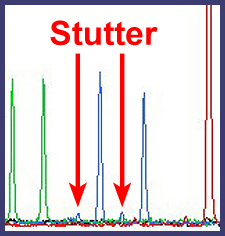Archival Notice
This is an archive page that is no longer being updated. It may contain outdated information and links may no longer function as originally intended.
Home | Glossary | Resources | Help | Contact Us | Course Map
Stutter is a by-product of the amplification of STR loci whereby a minor product, typically one repeat smaller than the primary allele, is generated. Sequence analysis of stutter products of STR loci has shown that the product is missing (or occasionally gained) one core repeat unit relative to the main allele. Stutter is thought to occur due to slipped strand mispairing during the amplification process. This happens during generation of the newly synthesized strand where one repeat unit temporarily dissociates, or "slips" away, from the template strand. When the polymerase works to re-associate the two strands, it miss pairs the two strands by one repeat unit thereby making the product strand one repeat unit shorter than the template. While this phenomenon can complicate the interpretation of forensic DNA profiles, stutter fortunately occurs in a reproducible and predictable fashion. The proportion of the stutter product relative to the main allele (percent stutter) is measured by dividing the height (or area) of the stutter peak by the height (or area) of the main allele peak.01
Typically, stutter is affected by:
- The repeat unit length (2 base pair repeats have higher stutter than 3 basepair, etc).
- The degree of homogeneity of repeats (the more homogenous, the higher the stutter).
- The length of the allele within a locus (the larger the alleles have higher stutter).
Read more about interpretation in this course.
he scientific community, as well as individual forensic laboratories, has conducted validation studies to determine the expected range of stutter percentages. In general, stutter percentages do not vary significantly.
There are two cases in which variability in the stutter percentages can be seen:
- Low-level samples (low RFUs)
- Samples exceeding the detection level of the instrument (excess DNA)
Additional Online Courses
- What Every First Responding Officer Should Know About DNA Evidence
- Collecting DNA Evidence at Property Crime Scenes
- DNA – A Prosecutor’s Practice Notebook
- Crime Scene and DNA Basics
- Laboratory Safety Programs
- DNA Amplification
- Population Genetics and Statistics
- Non-STR DNA Markers: SNPs, Y-STRs, LCN and mtDNA
- Firearms Examiner Training
- Forensic DNA Education for Law Enforcement Decisionmakers
- What Every Investigator and Evidence Technician Should Know About DNA Evidence
- Principles of Forensic DNA for Officers of the Court
- Law 101: Legal Guide for the Forensic Expert
- Laboratory Orientation and Testing of Body Fluids and Tissues
- DNA Extraction and Quantitation
- STR Data Analysis and Interpretation
- Communication Skills, Report Writing, and Courtroom Testimony
- Español for Law Enforcement
- Amplified DNA Product Separation for Forensic Analysts


